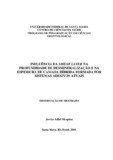| dc.creator | Skupien, Jovito Adiel | |
| dc.date.accessioned | 2010-04-16 | |
| dc.date.available | 2010-04-16 | |
| dc.date.issued | 2010-02-24 | |
| dc.identifier.citation | SKUPIEN, Jovito Adiel. INFLUENCE OF SMEAR LAYER IN THE DEPTH OF
DEMINERALIZATION AND THE THICKNESS OF HYBRID
LAYER PRODUCED BY CURRENT ADHESIVE SYSTEMS. 2010. 69 f. Dissertação (Mestrado em Odontologia) - Universidade Federal de Santa Maria, Santa Maria, 2010. | por |
| dc.identifier.uri | http://repositorio.ufsm.br/handle/1/6060 | |
| dc.description.abstract | The aim of this study was to evaluate the thickness of hybrid layer and the depth of demineralization produced by adhesive systems applied in dentinal surfaces submitted to
different treatments. Dentin slices extracted from 20 caries free human third molars were divided in two groups. One was polished with 60-grit SiC paper while the other was polished with 600-grit SiC. The samples were prepared to receive the treatment with self-etching adhesive systems: Adhe SE (AD), Clearfil SE Bond (CL), G Bond (GB) and total-etching adhesive system Adper Single Bond (SB). After treatment, the samples were fractured and prepared for SEM, to analyze the smear layer produced with each paper, the effect of conditioners and the thickness of hybrid layer produced by adhesives used. The data were
analyzed through ANOVA, with multiple comparisons post hoc using Tukey´s test. Correlation between depth of demineralization and thickness of hybrid layer was tested
through Spearman s correlation coefficient. Adhesive system and smear layer influenced the thickness of hybrid layer, where, the highest values were obtained for SB while the lowest, for GB. The phosphoric acid was able to demineralize dentin deeper, whereas GB did not promote any demineralization. The conditioners were more efficient on thin smear layer. It was demonstrated a direct correlation between depth of demineralization and thickness of
hybrid layer. The smear layer was able to influence the depth of demineralization and thickness of hybrid layer, however, for the total-etching adhesive system, the thickness of hybrid layer was independent of that. | eng |
| dc.description.sponsorship | Coordenação de Aperfeiçoamento de Pessoal de Nível Superior | |
| dc.format | application/pdf | por |
| dc.language | por | por |
| dc.publisher | Universidade Federal de Santa Maria | por |
| dc.rights | Acesso Aberto | por |
| dc.subject | Dentina | por |
| dc.subject | Adesivos dentinários | por |
| dc.subject | Desmineralização | por |
| dc.subject | Camada de esfregaço | por |
| dc.subject | Camada híbrida | por |
| dc.subject | Dentin | eng |
| dc.subject | Dentin bonding agents | eng |
| dc.subject | Demineralization | eng |
| dc.subject | Smear layer | eng |
| dc.subject | Hybrid layer | eng |
| dc.title | Influência da smear layer na profundidade de desmineralização e na espessura de camada híbrida formada por sistemas adesivos atuais. | por |
| dc.title.alternative | Influence of smear layer in the depth of demineralization and the thickness of hybrid layer produced by current adhesive systems | eng |
| dc.type | Dissertação | por |
| dc.description.resumo | O objetivo do estudo foi avaliar a espessura de camada híbrida e a profundidade de desmineralização produzida por sistemas adesivos aplicados sobre superfícies dentinárias
submetidas a diferentes tratamentos. Discos de dentina retirados de 20 dentes terceiros molares humanos livres de cárie foram seccionados, onde a metade foi submetida ao
tratamento com lixa 60# e a outra metade com lixa 600#. As amostras foram preparadas para receberem tratamento com os sistemas self-etching Adhe SE (AD), Clearfil SE Bond (CL), G Bond (GB) e o sistema total-etching Adper Single Bond (SB). Após aplicação, as amostras foram fraturadas e preparadas para a visualização em MEV, onde foi possível analisar a smear layer formada por cada lixa, a ação do condicionador e a espessura de camada híbrida formada pelos sistemas adesivos utilizados. Os dados foram analisados através do teste ANOVA, com comparações múltiplas post hoc realizadas utilizando teste de Tukey. Correlação entre profundidade de desmineralização e espessura de camada híbrida foi testada através do coeficiente de relação de Pearson. Sistema adesivo e smear layer influenciaram na
espessura de camada híbrida, onde, os maiores valores encontradas foram para SB e os menores para GB. O ácido fosfórico foi capaz de desmineralizar a dentina mais
profundamente, enquanto que GB não promoveu nenhuma desmineralização. Os condicionadores foram mais eficazes sobre smear layer delgada. Ficou demonstrada uma
correlação direta entre profundidade de desmineralização e espessura de camada híbrida. A smear layer é capaz de influenciar a profundidade de desmineralização e espessura de camada híbrida para os sistemas adesivos testados, porém, para o sistema adesivo total-etching a camada híbrida independe desta. | por |
| dc.contributor.advisor1 | Susin, Alexandre Henrique | |
| dc.contributor.advisor1Lattes | http://lattes.cnpq.br/5531102975088516 | por |
| dc.contributor.referee1 | Pozzobon, Roselaine Terezinha | |
| dc.contributor.referee1Lattes | http://lattes.cnpq.br/0725237903741859 | por |
| dc.contributor.referee2 | Durand, Letícia Brandão | |
| dc.contributor.referee2Lattes | http://lattes.cnpq.br/3552466367011940 | por |
| dc.creator.Lattes | http://lattes.cnpq.br/1391921073345927 | por |
| dc.publisher.country | BR | por |
| dc.publisher.department | Odontologia | por |
| dc.publisher.initials | UFSM | por |
| dc.publisher.program | Programa de Pós-Graduação em Ciências Odontológicas | por |
| dc.subject.cnpq | CNPQ::CIENCIAS DA SAUDE::ODONTOLOGIA | por |


